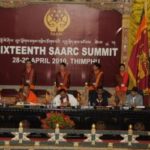 The 16th Summit was Bhutan’s first opportunity to host a SAARC Summit. The Summit was attended by eight Heads of States from South Asia on April 28-29. The theme of the Summit was to promote a ‘Green and Happy South Asia’. Following are some important decisions highlighted in the Summit Declaration.
The 16th Summit was Bhutan’s first opportunity to host a SAARC Summit. The Summit was attended by eight Heads of States from South Asia on April 28-29. The theme of the Summit was to promote a ‘Green and Happy South Asia’. Following are some important decisions highlighted in the Summit Declaration.
The leaders sought to promote people-centric development, culture, preservation of environment, better governance for enhancing the region’s Gross National Happiness (GNH). The Summit also approved Bhutan’s offer to host a SAARC Workshop on GNH in 2010.
In pursuance of the recommendation contained in the SAARC Ministerial Statement on Environment on conservation of aquatic ecosystem, trans-boundary bio-diversity zones, automated network of weather stations and regular and systematic sharing of scientific data, the Leaders called for focus on water management and conservation and development of cooperative projects at regional level in terms of exchange of best practices and knowledge, capacity building and transfer of eco-friendly technology. The Thimpu Statement on Climate Change provided the details of the SAARC programme to combat the challenge of climate change. Member states agreed to establish an Inter-governmental Expert Group on Climate Change to develop clear policy direction and guidance for regional cooperation as envisaged in the SAARC Plan of Action on Climate Change. It is interesting to note that SAARC countries viewed South Asia’s contribution to climate change is minimal while recognizing that it is a global phenomenon impacting all states.
The 16th Summit resolved to set up a South Asia Forum. The Forum would consist of eminent personalities of diverse background from all SAARC Member States to discuss, debate and exchange ideas. It is envisioned to function on public-private partnership lines, and allow for multiple inputs beyond governments into the consideration of the future of SAARC.
For the first time the efficacy of public diplomacy found mention in the SAARC declaration. Public awareness about SAARC programs and initiatives is very limited in the region. The realization that private media, think-tanks and civil society could be used to familiarize the people with regional initiatives is a welcome move.
The member states appreciated proposal by Bangladesh to convene an Inter-governmental meeting in Dhaka on the idea of a SAARC Charter of Democracy. Bangladesh also offered to circulate a Concept Paper on the theme.
Member States signed the SAARC Agreement on Trade in Services, which is expected to open up new vistas of trade cooperation and further deepen the integration of the regional economies.
The Leaders took note of the Reports of the Steering Committee of the South Asian
University, and appreciated the progress being made towards establishing the University. First academic session of the South Asian University would be initiated in August 2010.
The decade of 2010-2020 was declared as the “Decade of Intra-regional Connectivity in SAARC.” However, much progress could not be made on enhancing regional connectivity. A Motor Vehicles Agreement, providing for connectivity between Kabul and Dhaka criss-crossing the region, and a pact on Rapid Response to Natural Disasters was stalled after Pakistan refused to come on board.
The Leaders noted the proposal from India for preparing a Roadmap for developing a
SAARC Market for Electricity (SAME) on a regional basis, as SAARC is considering electricity trading, supported by enabling markets in the Member States.
Afghanistan’s President Hamid Karzai’s Statement at the Summit focused on the issue of terrorism as a regional threat. President Karzai explained in detail the rationale behind convening a Consultative Jirga on Peace. The thrust of Bangladesh’s Prime Minister Speech was the issue of climate change along with the suggestion to establish a Himalayan Council to coordinate a regional approach on climate change. Speech of India’s Prime Minister Manmohan Singh sounded like a Silver Jubilee review of SAARC, where he referred to the glass of regional cooperation and development as half empty. Apart from highlighting the achievements of ‘democratic’ Maldives President Mohamed Nasheed categorically emphasized for not making SAARC hostage to differences between India-Pakistan. Pakistan’s Prime Minister Gilani called for looking at terrorism as a socio-economic problem and favored enhancing SAARC’s engagement with other regional groups and countries.
The 16th SAARC Summit was mainly celebrated for contributing another thaw in India-Pakistan relations. The Singh-Gilani meeting on the sidelines of Summit, with the decision to resume bilateral dialogue marked the high-point of regional event. Leading Pakistan daily Dawn referred to the meeting as a ‘soft breakthrough’. The Hindu in India hailed it as an opportunity for ending the impasse. India-Pakistan dialogue process was suspended after the terror attacks in Mumbai in November 2008, allegedly conducted by Pakistan based terrorist group Lashkar-e-taiba.
Like most previous Summits, the Thimphu Summit allowed the South Asian States to formalize regional agreements on several social, economic and cultural issues. The problem for SAARC programs is largely in the implementation phase, when most member states disagree on modalities of operationalization. The success of SAARC hinges on sustained cooperation and judicious management of bilateral differences.